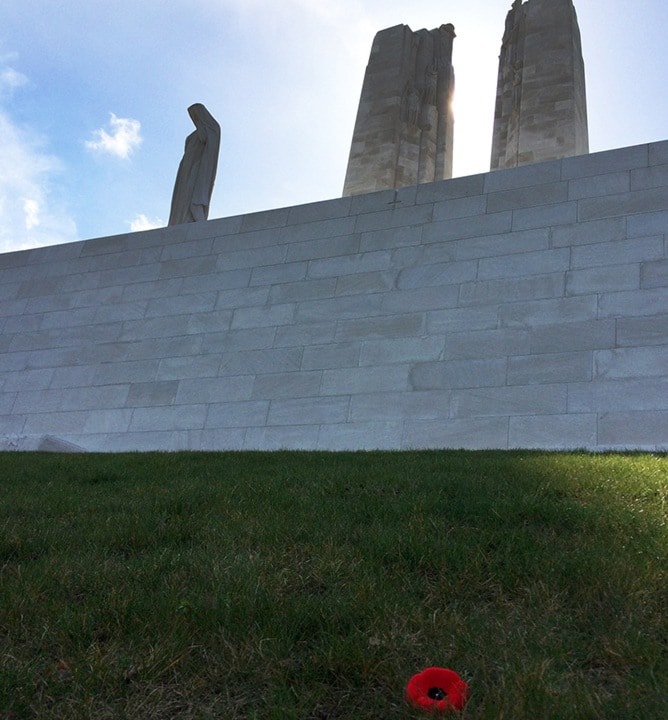Ninety-nine years after the Battle for Vimy Ridge, Canadians still remember the fateful day that Canadian Forces took the Vimy Ridge suffering major casualties in the process.
Members of the Ponoka Legion and students of the Ponoka Secondary Campus’ (PSC) Broncs World Tour program honoured these soldiers Saturday, April 9 with social studies teacher Ron Labrie explaining the symbolism behind the Vimy Ridge Memorial.
He and PSC students toured the memorial recently as part of the Broncs World Tour and he says it has special symbolism that touches his heart every time he visits. This year was no different.
France dedicated 250-acres of preserved battlefield and land to Canada and Labrie says it is his favourite Canadian land to visit.
There are 10 symbols as part of the memorial he feels are important to acknowledge and provided attendees with an explanation of each. Firstly Labrie spoke of a memorial called the Breaking of the Sword.
Three large sculpted figures are depicted with one kneeling and breaking a sword to symbolize a desire for peace and a need to demilitarize. A second symbol, the Statue of Mother Canada was created to mourn the dead Canadians.
“There’s so much emotion in that cold stone,” said Labrie.
The two familiar pillars that make up the most recognizable part of the memorial sit 30-metres above the stone platform. They represent Canada, with a maple leaf and France, with a fleur-de-lis symbolizing the unity of both countries. At the top of these two pylons are the Chorus, each representing these principles: justice and peace for one figure; then individually for hope, charity, honour and faith; and truth and knowledge for another.
Another symbol called the Mourning Parents represents a mother and father mourning after their children. Also part of the memorial is the Stone Sarcophagus and represents the unknown soldier, of which there were many, who died in battle.
On the base wall, there are the engraved 11,285 names of soldiers who died as well as those who were missing and presumed dead. Labrie said there are some cases where soldiers had the same names. In those situations the soldier’s regiment numbers are also included.
Another strong symbol, called the Sympathy of the Canadians for the Helpless, depicts three stricken figures while another man stands erect. Those figures are stricken with hunger or disease and the standing figure represents that of a person who shows sympathy to the weak and oppressed.
There is also a cannon wrapped with laurel and olive leaves that symbolize peace. Labrie said from his perspective he also sees this as showing the guns as silent.
At the base between the two pillars is the Spirit of Sacrifice, which has a light reference to the poem In Flander’s Fields, written by John McCrae. It depicts a dying soldier, in a crucifixion-like pose passing the torch to another soldier.
Labrie said this monument is to keep the the idea of remembrance alive.
“There’s not a symbol on this monument that represents destruction,” said Labrie of the peaceful display.
He suggests it speaks well of Canadian values but added the monument, which took 11 years to build, is a somber reminder of the effects of war. “It is still an ominous, awesome, unbelievable structure.”
Legion member Eldred Stamp said he saw the memorial in his youth approximately 65 years ago when doing an air force training exercise with the British. It left a lasting memory on him. “It is immense,” he said simply.
Student Lindsey Gartner was also impressed with the memorial from the tour. “It made you really proud to know that monument is going to be there, hopefully forever.”
Legion president Sybil Evans said the Legion continues to be thankful and suggests Canadians will never forget the sacrifices of past soldiers.
